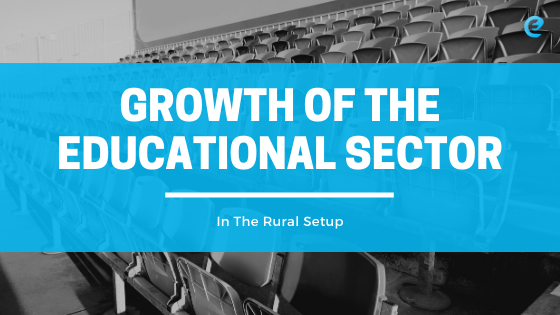It is an undeniable fact that rural India forms the backbone of the country as it forms the basis of this agrarian economy. Besides this, it is the home of a larger part of the Indian population and hence forms the greater portion of the youth as well. Therefore, the necessity of being literate of the rural population plays a vital role in our present and future. At the time of independence, the literacy rate of India was as low as 12% and the rural literacy rate was almost minimal. The educated mass of rural background was very low and illiteracy being the core of most problems was already playing its role. As soon as this truth was realized by the Indian Government, it started paying more attention to the literacy rates of the rural areas. From pumping money to forming schemes and building schools the government did whatever was within its capacity. It pushed the rural literacy rate from 12.1% in 1951 to 67.8% in 2011.
The education system is divided into three levels – primary, secondary and higher education. These levels are directed by the Indian Government to ensure that children between the ages of 6 to 14 attaining basic education. Emphasis on building a solid foundation of education was also recognized.
For these purposes, the following schemes were launched year after year to put the great impetus on rural education:
- “Non-formal Education Scheme” was introduced in 1979. Its purpose was to ensure that the formal system was providing education to all children below the age of 14 years. The NFE scheme is administered by State governments that set up NFE centers. This scheme also provides grants to voluntary agencies, which can run NFE centers. The Programme of Action (1992) had developed strategies for the running of the NFE scheme. These included the setting up of NFE centers based on a micro-planning exercise carried out for Universal Elementary Education, community participation by involving rural people in setting up the center, identification of instructor and supervision of NFE centers, and evolution of different models of NFE program for different target groups.
- Operation “Blackboard” was launched in 1987 to expand the basic facilities reaching to the public schools. The scheme made sure that in all primary schools there was at least one room for one class, a separate toilet for boys and girls, essential teaching-learning equipment, and other such facilities. A contingency grant was also to be made for replenishing items, consumable and minor repairs, etc. The scheme also undertook measures of training the teachers for using the teaching materials under a teacher training program, allotment of at least one teacher for each class or section and appointment of women for 50% of teacher posts to ensure a positive impact on girl child enrolments and retention
- “Mahila Samakya Scheme” which aims at educating women was launched in 1989 with help from the Netherlands. The scheme lays emphasis on educating the women so as to bring a change in their status. Its focus was primarily on rural women. The scheme made sure that more and more girls in rural areas attended the schools and improved their educational status. For this purpose women collectives were formed at the village level, resource agencies were created at the district and state level.
- In November 1994 the “District Primary Education Programme” was introduced. This program was launched to operationalize the strategies of “Universal Elementary Education”. In support of this the “National Programme of Nutritional Support to Primary Education” that is the “School Meal Programme” was launched on 15th August 1995. The scheme aims to increase admission of children and maintaining their attendance in primary classes by supplementing the nutritional requirements of children attending these primary schools from classes 1 to 5
- “Sarva Shiksha Abhiyan” launched in 2002 aims to provide useful and quality elementary education to children between 6 and 14 years of age by 2010. Its objective was to have all children in school by 2003. It made sure that all children complete primary schooling of five years by 2007. Its purpose was also to reduce the gap of education between the genders at the primary level of education by 2007 and elementary education by the year 2010.
All these efforts made by the Government resulted in increasing the rural male literacy rate from 19.02% in 1951 to 78.57% in 2011. The female literacy rate too increased from 4.87% in 1951 to 58.75% in 2011. The literacy rate of rural people of different ages also increased. The literacy rate of children of the age 5 and above increased from 67.3% in 2007 to 71.4 in 2014, of the age 7 and above increased from 67% in 2007 to 70.8% in 2014, of the age 15 and above increased from 59.7% in 2007 to 64.1% in 2014. The literacy rate of people of all ages (0 and above) increased from 60% in 2007 to 64.7% in 2014. The adult literacy rate of rural areas increased from 27.8% in 1951 to 69.3% in 2011 of 15 years of age and above.
As observed the increase in the educational sector of the rural setup is phenomenal. However, a lot of work still has to be done as we tend to make the literacy rate of 100%. The Indian Government needs to look into the rural education system to find the loopholes which absorb the 32.2% of the left literacy rate. There is no doubt that the primary schools in rural areas are provided education but coping with the current scenario of employment “quality education” is the goal towards which the government needs to strive. It has to make sure that the rural literate youth which qualifies every year is good to match the criteria demanded by the employers. Already unemployment is a major problem and we don’t want to worsen the condition with more people pouring in. Thus, we need to make sure that the rural youth is skilled enough to find it’s placed in companies and contributes to make India an industrial economy.



